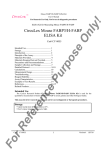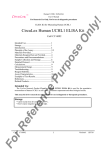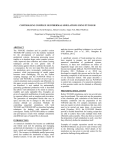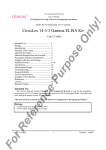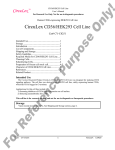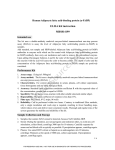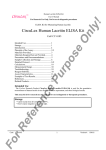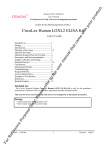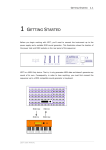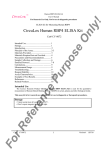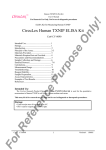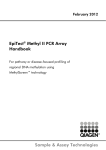Download For Reference Purpose Only!
Transcript
Mouse CIRP ELISA Kit User’s Manual For Research Use Only, Not for use in diagnostic procedures ELISA Kit for Measuring Mouse CIRP On ly! CircuLex TM CircuLex Mouse CIRP ELISA Kit Pu rp Intended Use................................................ 1 Storage......................................................... 1 Introduction.................................................. 2 Principle of the Assay.................................. 2-3 Materials Provided....................................... 3 Materials Required but not Provided........... 4 Precautions and Recommendations.............. 5 Sample Collection and Storage.................... 6-7 Detailed Protocol.......................................... 8-9 Calculations..................................…............ 10 Measurement Range..................................... 10 Troubleshooting............................................ 10 Reagent Stability.......................................... 10 Assay Characteristics................................... 11-13 Example of Test Results................................14 References.................................................... 15 Related Products.......................................... 16 os e Cat# CY-8102 ce Intended Use The CycLex Research Product CircuLex Mouse CIRP ELISA Kit is used for the quantitative measurement of mouse CIRP in ell lysate and other biological media. en This assay kit is for research use only and not for use in diagnostic or therapeutic procedures. Storage rR ef er • Upon receipt store all components at 4°C. • Don’t expose reagents to excessive light. Fo Cat#: CY-8102 1 Version#: 150611 Mouse CIRP ELISA Kit User’s Manual For Research Use Only, Not for use in diagnostic procedures On ly! CircuLex TM Introduction Principle of the Assay Pu rp os e CIRP, also known as CIRBP (cold inducible RNA binding protein), is a 172 amino acids protein belonging to the glycine-rich RNA binding protein family, which possesses an amino-terminal RNA recognition motif, and a carboxyl-terminal glycine-rich domain consisting of several RGG motifs (1). CIRP is constitutively expressed in a wide variety of tissues and cells in low amounts and can be induced by cellular stresses such as cold shock, UV irradiation and hypoxia (2-4). Upon stress induction, CIRP shuttles from the nucleus to the cytoplasm to stabilize target mRNAs (5, 6). CIRP might play a role in cellular processes such as transcription, translation and DNA recombination. It acts as an RNA chaperone to facilitate translation (7) and plays an important role in the circadian rhythm of living cells because CIRP is required for high-amplitude circadian gene expression (8). Another side to the picture, it was reported that CIRP is increased and released into the bloodstream in response to hemorrhagic shock and sepsis. When CIRP triggers inflammation, it contributes to damage of organs in the body (9). In macrophages under hypoxic stress, CIRP translocates from the nucleus to the cytosol and is released. The activity of extracellular CIRP is mediated through the Toll-like receptor 4-myeloid differentiation factor 2 complex (9). In conclusion, extracellular CIRP is an endogenous proinflammatory mediator and damage associated molecular pattern (DAMP) that triggers inflammatory responses during hemorrhagic shock and sepsis. rR ef er en ce The CycLex Research Product CircuLex Mouse CIRP ELISA Kit employs the quantitative sandwich enzyme immunoassay technique. A monoclonal antibody specific for CIRP is pre-coated onto a microplate. Standards and samples are pipetted into the wells and the immobilized antibody binds any CIRP present. After washing away any unbound substances, an HRP conjugated antibody specific for CIRP is added to the wells. Following a wash to remove any unbound antibody HRP conjugate, the remaining conjugate is allowed to react with the substrate H2O2-tetramethylbenzidine. The reaction is stopped by addition of acidic solution and absorbance of the resulting yellow product is measured at 450 nm. The absorbance is proportional to the concentration of mouse CIRP. A standard curve is constructed by plotting absorbance values versus mouse CIRP concentrations of calibrators, and concentrations of unknown samples are determined using this standard curve. Fo Cat#: CY-8102 2 Version#: 150611 Mouse CIRP ELISA Kit User’s Manual For Research Use Only, Not for use in diagnostic procedures Summary of Procedure Add 100 µL of diluted samples to the wells Incubate for 1 hour at room temp. Wash the wells Add 100 µL of HRP conjugated anti-mouse CIRP antibody Wash the wells Add 100 µL of Substrate Reagent Pu rp Add 100 µL of Stop Solution os e Incubate for 1 hour at room temp. On ly! CircuLex TM Measure absorbance at 450 nm Materials Provided All samples and standards should be assayed in duplicate. The following components are supplied and are sufficient for the one 96-well microplate kit. ce Microplate: One microplate supplied ready to use, with 96 wells (12 strips of 8-wells) in a foil, zip-lock bag with a desiccant pack. Wells are coated with anti-CIRP monoclonal antibody as a capture antibody. 10X Wash Buffer: One bottle containing 100 mL of 10X buffer containing Tween®-20 en Dilution Buffer: One bottle containing 50 mL of 1X buffer; use for reconstitution of Mouse CIRP Standard and sample dilution. Ready to use. Mouse CIRP Standard: One vial containing 500 ng of lyophilized recombinant mouse CIRP. er HRP conjugated Detection Antibody: One bottle containing 12 mL of HRP (horseradish peroxidase) conjugated anti-CIRP antibody. Ready to use. ef Substrate Reagent: One bottle containing 20 mL of the chromogenic substrate, tetra-methylbenzidine (TMB). Ready to use. rR Stop Solution: One bottle containing 20 mL of 1 N H2SO4. Ready to use. Fo Cat#: CY-8102 3 Version#: 150611 Mouse CIRP ELISA Kit User’s Manual For Research Use Only, Not for use in diagnostic procedures On ly! CircuLex TM Materials Required but not Provided • Pipettors: 2-20 µL, 20-200 µL and 200-1000 µL precision pipettors with disposable tips • Precision repeating pipettor • Orbital microplate shaker • Microcentrifuge and tubes for sample preparation os e • Vortex mixer • Microplate washer: optional (Manual washing is possible but not preferable) • Plate reader: capable of measuring absorbance in 96-well plates at dual wavelengths of 450/540 nm. Dual wavelengths of 450/550 or 450/595 nm can also be used. The plate can also be read at a single wavelength of 450 nm, which will give a somewhat higher reading. • 500 or 1000 mL graduated cylinder • Reagent reservoirs • Deionized water of the highest quality rR ef er en ce • Disposable paper towels Pu rp • Software package facilitating data generation and analysis: optional Fo Cat#: CY-8102 4 Version#: 150611 Mouse CIRP ELISA Kit User’s Manual For Research Use Only, Not for use in diagnostic procedures Precautions and Recommendations • Allow all the components to come to room temperature before use. On ly! CircuLex TM • All microplate strips that are not immediately required should be returned to the zip-lock pouch, which must be carefully resealed to avoid moisture absorption. • Do not use kit components beyond the indicated kit expiration date. os e • Use only the microtiter wells provided with the kit. • Rinse all detergent residues from glassware. • Use deionized water of the highest quality. • Do not mix reagents from different kits. Pu rp • The buffers and reagents used in this kit contain NaN3 as preservatives. Care should be taken to avoid direct contact with these reagents. • Do not mouth pipette or ingest any of the reagents. • Do not smoke, eat, or drink when performing the assay or in areas where samples or reagents are handled. • Dispose of tetra-methylbenzidine (TMB) containing solutions in compliance with local regulations. • Avoid contact with the acidic Stop Solution and Substrate Solution, which contains hydrogen peroxide. ce • Wear gloves and eye protection when handling immunodiagnostic materials and samples of mouse origin, and these reagents. In case of contact with the Stop Solution and the Substrate Solution, wash skin thoroughly with water and seek medical attention, when necessary. en • Biological samples may be contaminated with infectious agents. Do not ingest, expose to open wounds or breathe aerosols. Wear protective gloves and dispose of biological samples properly. rR ef er • CAUTION: Sulfuric Acid is a strong acid. Wear disposable gloves and eye protection when handling Stop Solution. Fo Cat#: CY-8102 5 Version#: 150611 Mouse CIRP ELISA Kit User’s Manual For Research Use Only, Not for use in diagnostic procedures On ly! CircuLex TM Sample Collection and Storage Cell lysates: Prepare cell lysates (see below). Assay immediately or store the samples on ice for a few hours before assaying. Aliquots of the samples may also be stored at below -70°C for extended periods of time. Avoid repeated freeze-thaw cycles. Other biological samples: Remove any particulates by centrifugation and assay immediately or aliquot and store samples at below -70°C. Avoid repeated freeze-thaw cycles. os e For reference Serum: Use a serum separator tube and allow samples to clot for 60 ± 30 minutes. Centrifuge the samples at 4°C for 10 minutes at 1,000 x g. Remove serum and assay immediately or store samples on ice for up to 6 hours before assaying. Aliquots of serum may also be stored at below -70°C for extended periods of time. Avoid repeated freeze-thaw cycles. Pu rp Plasma: Collect plasma using EDTA-Na2 as the anticoagulant. If possible, collect the plasma into a mixture of EDTA-Na2 and Futhan (FUT175) to stabilize the sample against spontaneous in vitro complement activation. Immediately centrifuge samples at 4°C for 15 minutes at 1,000 x g. Assay immediately or store samples on ice for up to 6 hours before assaying. Aliquots of plasma may also be stored at below -70°C for extended periods of time. Avoid repeated freeze-thaw cycles. Note: Citrate plasma has not been validated for use in this assay. ce Preparation of Cell Lysate: Several extraction methods can be used for measurement cellular total CIRP. The following protocol has been shown to work with a number of different cell lines and is provided as an example of suitable methods. It is strongly advised that the user always perform an initial experiment to determine the proper dilution to be used in subsequent experiments. This need not be any more than a single time point assay using serial dilutions of the cell lysate. One eight well strip of the substrate plate should be sufficient for this initial experiment. All steps of cell lysate preparation should be performed at 4°C and recovered cell lysate should be kept at -70°C. en A. Cell Lysis Buffer 50 mM Tris HCl, pH 7.5, 250 mM NaCl, 10 % glycerol, 0.1 % NP-40, 5 mM EDTA-2Na (pH 7.5), 0.2 mM PMSF, 1 µg/mL pepstatin, 0.5 µg/mL leupeptin, 0.2 mM DTT er B. Preparation of poly-L-lysine coated plate Coat the dish with 25 µg/mL poly-l-lysine (PLL) in PBS for 4-12 hours at 37°C. Subsequently go to a washing step with PBS. C. Treatment of Cells 1. Plate adherent cells in PLL-coatedφ6 cm dish at around 3 x 105 cells/dish. ef 2. Incubate the culture dish at 37°C overnight in CO2 incubator. rR 3. Incubate the culture dish at 32°C for 8-24 hours in CO2 incubator (cold treatment). or Fo Cat#: CY-8102 6 Version#: 150611 Mouse CIRP ELISA Kit User’s Manual For Research Use Only, Not for use in diagnostic procedures On ly! CircuLex TM 3’. Add appropriate amount of test compound and vehicle to each well. Incubate the culture dish at 37°C for appropriate time (drug treatment). D. Cell Extraction Note: This protocol has been successfully applied to Balb/3T3 cell line. Users should optimize the cell extraction procedure for their own applications. os e 4. Wash cells three times with ice-cold PBS. Remove any remaining PBS by decanting. Invert the dish and blot it against clean paper towels. At this point the cells in the plate can be frozen at below -70°C and lysed at a later date. 5. Lyse the cells by adding 0.2 mL* of Cell Lysis Buffer for 60-90 minutes at 4°C, with rotating at ca. 300 rpm by an orbital microplate shaker. Pu rp * To get a rough idea you could adjust the cell concentration to around 2-4 x 106 cells/mL in Cell Lysis Buffer. Resulting protein concentration of the Balb/3T3 cell lysate should be 0.8-1.6 mg/mL using this procedure. * The appropriate volume of Cell Lysis Buffer depends on the cell line, the cell number and the amount of total CIRP. 6. Transfer the cell lysates to microcentrifuge tubes and centrifuge at 15,000 rpm for 5 minutes at 4°C. 7. Transfer the clear cell lysates to new microcentrifuge tubes. Dilute these cell lysates 50-100 times with Dilution Buffer. 100 µL of these diluted cell lysates are ready for assay. Go to the section “Standard Assay Procedure for Mouse CIRP” below. Typical data using this protocol are shown in Fig.1 of the section "Example of Test Results" below. ce The cell lysates can be stored at below -70°C. Avoid multiple freeze/thaw cycles. After thaw the cell lysates, Centrifuge at 15,000 rpm for 5 minutes at 4°C again since the cell lysates should be clear of any sediments or particulate matter. rR ef er en NOTE: THE ABOVE PROCEDURES ARE INTENDED ONLY AS A GUIDELINE. THE OPTIMAL EXPERIMENTAL CONDITIONS WILL VARY DEPENDING ON THE PARAMETERS BEING INVESTIGATED, AND MUST BE DETERMINED BY THE INDIVIDUAL USER. NO WARRANTY OR GUARANTEE OF PERFORMANCE USING THESE PROCEDURES IS MADE OR IMPLIED. Fo Cat#: CY-8102 7 Version#: 150611 CircuLex Mouse CIRP ELISA Kit User’s Manual For Research Use Only, Not for use in diagnostic procedures On ly! TM Detailed Protocol The CycLex Research Product CircuLex Mouse CIRP ELISA Kit is provided with removable strips of wells so the assay can be carried out on separate occasions using only the number of strips required for the particular determination. Since experimental conditions may vary, an aliquot of the Mouse CIRP Standard within the kit should be included in each assay as a calibrator. Disposable pipette tips and reagent troughs should be used for all liquid transfers to avoid cross-contamination of reagents or samples. Preparation of Working Solutions os e All reagents need to be brought to room temperature prior to the assay. Assay reagents are supplied ready-to-use, with the exception of 10X Wash Buffer and Mouse CIRP Standard. 1. Prepare a working solution of Wash Buffer by adding 100 mL of the 10X Wash Buffer to 900 mL of deionized (distilled) water. Mix well. Store at 4°C for two weeks or -20°C for long-term storage. Pu rp 2. Reconstitute Mouse CIRP Standard with 1 mL of Dilution Buffer. The concentration of the mouse CIRP in vial should be 500 ng/mL, which is referred as a Master Standard of Mouse CIRP. Prepare Standard Solutions as follows: Use the Master Standard to produce a dilution series (below). Mix each tube thoroughly before the next transfer. The 40 ng/mL standard (Std.1) serves as the highest standard. The Dilution Buffer serves as the zero standard (Blank). Volume of Standard 80 µL of Master Standard (500 ng/mL) 300 µL of Std. 1 (40 ng/mL) 300 µL of Std. 2 (20 ng/mL) 300 µL of Std. 3 (10 ng/mL) 300 µL of Std. 4 (5 ng /mL) 300 µL of Std. 5 (2.5 ng/mL) 300 µL of Std. 6 (1.25 ng /mL) ce Std.1 Std.2 Std.3 Std.4 Std.5 Std.6 Std.7 Blank en - Dilution Buffer 920 µL 300 µL 300 µL 300 µL 300 µL 300 µL 300 µL 300 µL Concentration 40 ng/mL 20 ng/mL 10 ng/mL 5 ng/mL 2.5 ng/mL 1.25 ng/mL 0.625 ng/mL 0 ng /mL er Note: Do not use a repeating pipette. Change tips for every dilution. Unused portions of Master Standard should be aliquoted and stored at below -70°C immediately. Avoid multiple freeze and thaw cycles. Sample Preparation rR ef • Cell lysates require neat to appropriate dilution. • Serum or plasma requires at least a 50-fold dilution. Fo Cat#: CY-8102 8 Version#: 150611 Mouse CIRP ELISA Kit User’s Manual For Research Use Only, Not for use in diagnostic procedures Standard Assay Procedure for Mouse CIRP On ly! CircuLex TM 1. Remove the appropriate number of microtiter wells from the foil pouch and place them into the well holder. Return any unused wells to the foil pouch, refold, seal with tape and store at 4°C. 2. Dilute samples with Dilution Buffer. (See “Sample Preparation” above.) 3. Pipette 100 µL of Standard Solutions (Std1-Std7, Blank) and diluted samples in duplicates, into the appropriate wells. os e 4. Incubate the plate at room temperature (ca.25°C) for 1 hour, shaking at ca. 300 rpm on an orbital microplate shaker. 5. Wash 4-times by filling each well with Wash Buffer (350 µL) using a squirt bottle, multi-channel pipette, manifold dispenser or microplate washer. 6. Add 100 µL of HRP conjugated Detection Antibody into each well. Pu rp 7. Incubate the plate at room temperature (ca.25°C) for 1 hour, shaking at ca. 300 rpm on an orbital microplate shaker. 8. Wash 4-times by filling each well with Wash Buffer (350 µL) using a squirt bottle, multi-channel pipette, manifold dispenser or microplate washer. 9. Add 100 µL of Substrate Reagent. Avoid exposing the microtiter plate to direct sunlight. Covering the plate with e.g. aluminum foil is recommended. Return Substrate Reagent to 4°C immediately after the necessary volume is removed ce 10. Incubate the plate at room temperature (ca.25°C) for 10-20 minutes, shaking at ca. 300 rpm on an orbital microplate shaker. The incubation time may be extended up to 30 minutes if the reaction temperature is below 20°C. 11. Add 100 µL of Stop Solution to each well in the same order as the previously added Substrate Reagent. en 12. Measure absorbance in each well using a spectrophotometric microplate reader at dual wavelengths of 450/540 nm. Dual wavelengths of 450/550 or 450/595 nm can also be used. Read the microplate at 450 nm if only a single wavelength can be used. Wells must be read within 30 minutes of adding the Stop Solution. rR ef er Note-1: Complete removal of liquid at each step is essential to good performance. After the last wash, remove any remaining Wash Buffer by aspirating or decanting. Invert the plate and blot it against clean paper towels. Note-2: Reliable standard curves are obtained when either O.D. values do not exceed 0.25 units for the blank (zero concentration), or 3.0 units for the highest standard concentration. The plate should be monitored at 5-minute intervals for approximately 30 minutes. Note-3: If the microplate reader is not capable of reading absorbance greater than the absorbance of the highest standard, perform a second reading at 405 nm. A new standard curve, constructed using the values measured at 405 nm, is used to determine mouse CIRP concentration of off-scale samples. The readings at 405 nm should not replace the on-scale readings at 450 nm. Fo Cat#: CY-8102 9 Version#: 150611 Mouse CIRP ELISA Kit User’s Manual For Research Use Only, Not for use in diagnostic procedures On ly! CircuLex TM Calculations os e Average the duplicate readings for each standard, control, and sample and subtract the average zero standard optical density. Plot the optical density for the standards versus the concentration of the standards and draw the best curve. The data can be linearized by using log/log paper and regression analysis may be applied to the log transformation. To determine the mouse CIRP concentration of each sample, first find the absorbance value on the y-axis and extend a horizontal line to the standard curve. At the point of intersection, extend a vertical line to the x-axis and read the corresponding mouse CIRP concentration. If the samples have been diluted, the concentration read from the standard curve must be multiplied by the dilution factor. 1. The dose-response curve of this assay fits best to a sigmoidal 4-parameter logistic equation. The results of unknown samples can be calculated with any computer program having a 4-parameter logistic function. It is important to make an appropriate mathematical adjustment to accommodate for the dilution factor. Pu rp 2. Most microtiter plate readers perform automatic calculations of analyte concentration. The calibration curve is constructed by plotting the absorbance (Y) of calibrators versus log of the known concentration (X) of calibrators, using the 4-parameter function. Alternatively, the logit log function can be used to linearize the calibration curve (i.e. logit of absorbance (Y) is plotted versus log of the known concentration (X) of calibrators). Measurement Range The measurement range is 0.625 ng/mL to 40 ng/mL. Any sample reading higher than the highest standard should be diluted with Dilution Buffer in higher dilution and re-assayed. Dilution factors need to be taken into consideration in calculating the mouse CIRP concentration. ce Troubleshooting 1. The Mouse CIRP Standard should be run in duplicate, using the protocol described in the Detailed Protocol. Incubation times or temperatures significantly different from those specified may give erroneous results. en 2. Poor duplicates, accompanied by elevated values for wells containing no sample, indicate insufficient washing. If all instructions in the Detailed Protocol were followed accurately, such results indicate a need for washer maintenance. er 3. Overall low signal may indicate that desiccation of the plate has occurred between the final wash and addition of Substrate Reagent. Do not allow the plate to dry out. Add Substrate Reagent immediately after wash. ef Reagent Stability rR All of the reagents included in the CycLex Research Product CircuLex Mouse CIRP ELISA Kit have been tested for stability. Reagents should not be used beyond the stated expiration date. Upon receipt, kit reagents should be stored at 4°C, except the reconstituted Mouse CIRP Standard must be stored at below -70°C. Coated assay plates should be stored in the original foil bag sealed by the zip lock and containing a desiccant pack. Fo Cat#: CY-8102 10 Version#: 150611 Mouse CIRP ELISA Kit User’s Manual For Research Use Only, Not for use in diagnostic procedures On ly! CircuLex TM Assay Characteristics 1. Sensitivity The limit of detection (defined as such a concentration of mouse CIRP giving absorbance higher than mean absorbance of blank* plus three standard deviations of the absorbance of blank: A blank + 3SD blank) is better than 0.159 ng/mL of sample. * Dilution Buffer is pipetted into blank wells. rR ef er en ce Pu rp os e Typical Standard Curve Fo Cat#: CY-8102 11 Version#: 150611 Mouse CIRP ELISA Kit User’s Manual For Research Use Only, Not for use in diagnostic procedures On ly! CircuLex TM 2. Precision Intra-assay Precision (Precision within an assay) Three samples* of known concentration were tested twelve times on one plate to assess intra-assay precision. • Intra-assay (Within-Run, n=12) CV=2.0-5.1 % *Sample: Cell lysate Pu rp os e Mouse CIRP conc. (ng/ml) ce Inter-assay Precision (Precision between assays) Three samples* of known concentration were tested in four separate assays to assess inter-assay precision. • Inter-assay (Run-to-Run, n=4) CV=1.1-8.8% *Sample: Cell lysate rR ef er en Mouse CIRP conc. (ng/ml) Fo Cat#: CY-8102 12 Version#: 150611 Mouse CIRP ELISA Kit User’s Manual For Research Use Only, Not for use in diagnostic procedures On ly! CircuLex TM 3. Linearity rR ef er en ce Pu rp os e Three samples* were diluted with Dilution Buffer and assayed after dilution. The neat sample is set to 1. *Sample: Cell lysate Fo Cat#: CY-8102 13 Version#: 150611 Mouse CIRP ELISA Kit User’s Manual For Research Use Only, Not for use in diagnostic procedures On ly! CircuLex TM Example of Test Results Pu rp os e Fig.1 Mouse CIRP concentration in Balb/3T3 cell lysate after low temperature treatment (at 32°C) for indicated times rR ef er en ce Fig.2 Mouse CIRP concentration in mouse liver homogenate Fo Cat#: CY-8102 14 Version#: 150611 Mouse CIRP ELISA Kit User’s Manual For Research Use Only, Not for use in diagnostic procedures On ly! CircuLex TM References 1. Nishiyama H, Higashitsuji H, Yokoi H, et al. Cloning and characterization of human CIRP (coldinducible RNA-binding protein) cDNA and chromosomal assignment of the gene. Gene. 1997; 204:115–120. 2. Nishiyama H, Itoh K, Kaneko Y, Kishishita M, Yoshida O, Fujita J. A glycine-rich RNA-binding protein mediating cold-inducible suppression of mammalian cell growth. J Cell Biol. 1997; 137:899–908. os e 3. Sheikh MS, Carrier F, Papathanasiou MA, et al. Identification of several human homologs of hamster DNA damage-inducible transcripts. Cloning and characterization of a novel UV-inducible cDNA that codes for a putative RNA-binding protein. J Biol Chem. 1997; 272:26720–26726. Pu rp 4. Wellmann S, Buhrer C, Moderegger E, et al. Oxygen-regulated expression of the RNA-binding proteins RBM3 and CIRP by a HIF-1-independent mechanism. J Cell Sci. 2004; 117:1785–1794. 5. De Leeuw F, Zhang T, Wauquier C, Huez G, Kruys V, Gueydan C. The cold-inducible RNAbinding protein migrates from the nucleus to cytoplasmic stress granules by a methylationdependent mechanism and acts as a translational repressor. Exp Cell Res. 2007; 313:4130–4144. 6. Yang C, Carrier F. The UV-inducible RNA-binding protein A18 (A18 hnRNP) plays a protective role in the genotoxic stress response. J Biol Chem. 2001; 276:47277–47284. ce 7. Gualerzi CO, Giuliodori AM, Pon CL. Transcriptional and posttranscriptional control of cold-shock genes. J Mol Biol. 2003; 331: 527–539. en 8. Morf J, Rey G, Schneider K, Stratmann M, Fujita J. et al. Cold-inducible RNA-binding protein modulates circadian gene expression posttranscriptionally. Science 2013; 338: 379–383. rR ef er 9. Qiang X, Yang WL, Wu R, Zhou M, Jacob A. et al. Cold-inducible RNA-binding protein (CIRP) triggers inflammatory responses in hemorrhagic shock and sepsis. Nat Med. 2013; 19:1489-95 Fo Cat#: CY-8102 15 Version#: 150611 Mouse CIRP ELISA Kit User’s Manual For Research Use Only, Not for use in diagnostic procedures On ly! CircuLex TM Related Products os e * CircuLex Mouse ISG15 ELISA Kit: CY-8091 * CircuLex Mouse FABP1/L-FABP ELISA Kit: CY-8054 * CircuLex Mouse FABP3/H-FABP ELISA Kit: CY-8055 * CircuLex Mouse FABP4/A-FABP ELISA Kit: CY-8077 * CircuLex Mouse FABP5/E-FABP/mal1 ELISA Kit: CY-8056 * CircuLex Mouse UCHL1 ELISA Kit: CY-8093 * CircuLex Mouse Visfatin/PBEF ELISA Kit: CY-8065 PRODUCED BY Pu rp CycLex Co., Ltd. 1063-103 Terasawaoka Ina, Nagano 396-0002 Japan Fax: +81-265-76-7618 e-mail: [email protected] URL: http://www.cyclex.co.jp rR ef er en ce CycLex/CircuLex products are supplied for research use only. CycLex/CircuLex products and components thereof may not be resold, modified for resale, or used to manufacture commercial products without prior written approval from CycLex Co., Ltd.. To inquire about licensing for such commercial use, please contact us via email. Fo Cat#: CY-8102 16 Version#: 150611
















